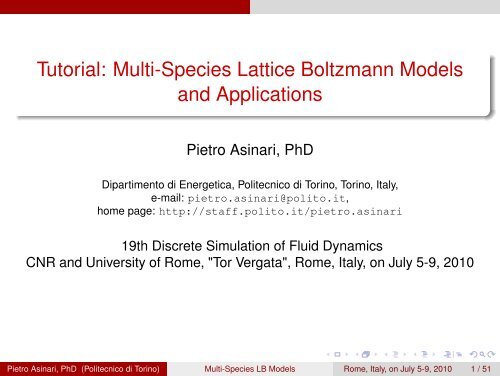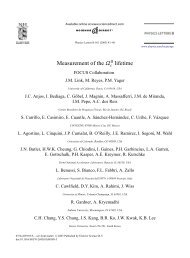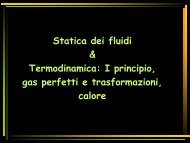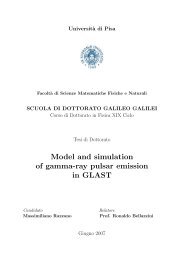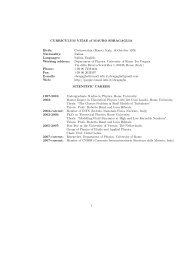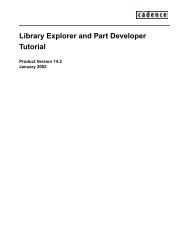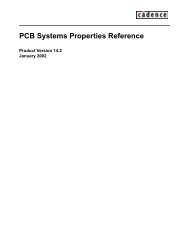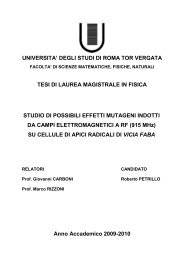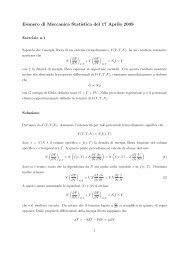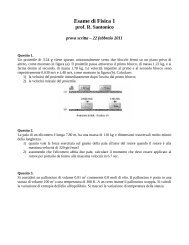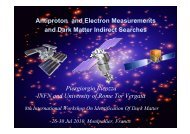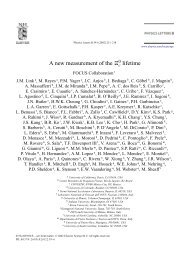Tutorial: Multi-Species Lattice Boltzmann Models and Applications
Tutorial: Multi-Species Lattice Boltzmann Models and Applications
Tutorial: Multi-Species Lattice Boltzmann Models and Applications
Create successful ePaper yourself
Turn your PDF publications into a flip-book with our unique Google optimized e-Paper software.
<strong>Tutorial</strong>: <strong>Multi</strong>-<strong>Species</strong> <strong>Lattice</strong> <strong>Boltzmann</strong> <strong>Models</strong><br />
<strong>and</strong> <strong>Applications</strong><br />
Pietro Asinari, PhD<br />
Dipartimento di Energetica, Politecnico di Torino, Torino, Italy,<br />
e-mail: pietro.asinari@polito.it,<br />
home page: http://staff.polito.it/pietro.asinari<br />
19th Discrete Simulation of Fluid Dynamics<br />
CNR <strong>and</strong> University of Rome, "Tor Vergata", Rome, Italy, on July 5-9, 2010<br />
Pietro Asinari, PhD (Politecnico di Torino) <strong>Multi</strong>-<strong>Species</strong> LB <strong>Models</strong> Rome, Italy, on July 5-9, 2010 1 / 51
Abstract of this tutorial<br />
The aim of this tutorial is to discuss a numerical scheme based on the<br />
<strong>Lattice</strong> <strong>Boltzmann</strong> Method (LBM) for gas mixture modeling, which fully<br />
recovers Maxwell-Stefan diffusion model in the continuum limit, without<br />
the restriction of the mixture-averaged approximation [1]. The<br />
mixture-averaged approximation is used to express the molar<br />
concentration gradient by means of a Fickian expression <strong>and</strong> a proper<br />
diffusion coefficient, both designed in such a way to be consistent with<br />
the Maxwell-Stefan formulation only in some limiting cases.<br />
Unfortunately (a) this approximation yields to Fickian diffusion<br />
coefficients depending on both the fluid transport properties <strong>and</strong> the<br />
local flow <strong>and</strong> (b) it is not valid in general. The key idea for avoiding<br />
these problems is to start from a Bhatnagar-Gross-Krook-type kinetic<br />
model for gas mixtures, recently proposed by Andries, Aoki <strong>and</strong><br />
Perthame [2] (the so-called AAP model).<br />
Pietro Asinari, PhD (Politecnico di Torino) <strong>Multi</strong>-<strong>Species</strong> LB <strong>Models</strong> Rome, Italy, on July 5-9, 2010 2 / 51
Outline of this tutorial<br />
1 Kinetic theory of rarefied gas mixtures<br />
Full <strong>Boltzmann</strong> equations<br />
Exchange relation for momentum<br />
2 <strong>Lattice</strong> <strong>Boltzmann</strong> solvers <strong>and</strong> applications<br />
Single-relaxation-time <strong>Lattice</strong> <strong>Boltzmann</strong> scheme<br />
Andries-Aoki-Perthame (AAP) model<br />
LBM formulation by variable transformation<br />
3 Validation <strong>and</strong> simple applications<br />
Pietro Asinari, PhD (Politecnico di Torino) <strong>Multi</strong>-<strong>Species</strong> LB <strong>Models</strong> Rome, Italy, on July 5-9, 2010 3 / 51
Kinetic theory of rarefied gas mixtures<br />
Outline Compass<br />
1 Kinetic theory of rarefied gas mixtures<br />
Full <strong>Boltzmann</strong> equations<br />
Exchange relation for momentum<br />
2 <strong>Lattice</strong> <strong>Boltzmann</strong> solvers <strong>and</strong> applications<br />
Single-relaxation-time <strong>Lattice</strong> <strong>Boltzmann</strong> scheme<br />
Andries-Aoki-Perthame (AAP) model<br />
LBM formulation by variable transformation<br />
3 Validation <strong>and</strong> simple applications<br />
Pietro Asinari, PhD (Politecnico di Torino) <strong>Multi</strong>-<strong>Species</strong> LB <strong>Models</strong> Rome, Italy, on July 5-9, 2010 4 / 51
Kinetic theory of rarefied gas mixtures<br />
Full <strong>Boltzmann</strong> equations<br />
Full <strong>Boltzmann</strong> equations for gas mixtures<br />
The simultaneous <strong>Boltzmann</strong> equations for a mixture without<br />
external force can be written as [3, 4, 5, 6]:<br />
∂ t f σ + ξ·∇f σ + a σ ·∇ ξ f σ = Q σ = ∑ ς<br />
Q σς , (1)<br />
where Q σς = Q ςσ , ς ≠ σ, is the cross collision term for two<br />
different species σ (with mass m σ ) <strong>and</strong> ς (with mass m ς ).<br />
Obviously, for an N-component system, there will be N such<br />
equations. In general, the collision term is<br />
∫ ∫<br />
Q σς ˙= K σς (g, n) [ f σ (ξ ′ )f ς (ξ ∗) ′ − f σ (ξ)f ς (ξ ∗ ) ] dn dξ ∗ ,<br />
R 3 ξ<br />
g·n
Kinetic theory of rarefied gas mixtures<br />
Full <strong>Boltzmann</strong> equations<br />
Collision kernel <strong>and</strong> post–collision velocities<br />
The weight K σς (g, n) = K ςσ (g, n) is a volumetric particle flux or<br />
collision kernel. In the following, we will discuss only the case of<br />
Maxwell molecules [7], namely K σς (|g · n|/|g|), where the collision<br />
kernel is independent of the relative velocity.<br />
In the previous equation, the post–collision test <strong>and</strong> field particle<br />
velocities ξ ′ <strong>and</strong> ξ ′ ∗ are given by<br />
ξ ′ = ξ + 2µ σς<br />
m σ<br />
(g · n) n, (3)<br />
ξ ′ ∗ = ξ ∗ − 2µ σς<br />
m ς<br />
(g · n) n, (4)<br />
which means that there are many possible outcomes (ξ ′ , ξ ′ ∗) from<br />
a given pair of incoming (test <strong>and</strong> field) particle velocities (ξ, ξ ∗ ),<br />
depending on the impact direction n.<br />
The reduced mass µ σς is defined as<br />
µ σς = m σ m ς /(m σ + m ς ). (5)<br />
Pietro Asinari, PhD (Politecnico di Torino) <strong>Multi</strong>-<strong>Species</strong> LB <strong>Models</strong> Rome, Italy, on July 5-9, 2010 6 / 51
Kinetic theory of rarefied gas mixtures<br />
Full <strong>Boltzmann</strong> equations<br />
Indifferentiability Principle <strong>and</strong> H–theorem<br />
Indifferentiability Principle: when all the masses m σ <strong>and</strong><br />
cross-sections K σς are identical, the total distribution f = ∑ σ f σ<br />
obeys the single species <strong>Boltzmann</strong> equation.<br />
H–theorem: in the case of a mixture, the entropy inequality<br />
(H–theorem) is<br />
∑<br />
∫<br />
Q σ log(f σ )dξ ≤ 0. (6)<br />
σ<br />
R 3 ξ<br />
These properties of the full <strong>Boltzmann</strong> equations for mixtures will<br />
guide the design of BGK–type simplified models <strong>and</strong> consequently<br />
of the <strong>Lattice</strong> <strong>Boltzmann</strong> solvers.<br />
Pietro Asinari, PhD (Politecnico di Torino) <strong>Multi</strong>-<strong>Species</strong> LB <strong>Models</strong> Rome, Italy, on July 5-9, 2010 7 / 51
Kinetic theory of rarefied gas mixtures<br />
Exchange relation for momentum<br />
Exchange relation for momentum (1 of 3)<br />
The momentum equation is<br />
∫<br />
∂ t (ρ σ u σ ) + ∇ · Π σ = ρ σ a σ +<br />
R 3 ξ<br />
m σ ξQ σ dξ. (7)<br />
Taking into account the symmetries of the elementary collision<br />
yields (see for example Eq. (48) in the Ref. [8])<br />
∫<br />
m σ ξQ σ dξ = ∑ 〈∫<br />
〉<br />
K σς (|g · n|/|g|) m σ (ξ ′ − ξ) dn ,<br />
R 3 ξ ς g·n
Kinetic theory of rarefied gas mixtures<br />
Exchange relation for momentum<br />
Exchange relation for momentum (2 of 3)<br />
Let us express the surface element dn in Eq. (10) by using g as<br />
polar axis, φ as polar angle <strong>and</strong> θ as azimuthal angle.<br />
Hence K σς (|g · n|/|g|) = K σς (cos φ) = K σς (φ) <strong>and</strong> consequently<br />
∫<br />
m σ ξQ σ dξ = ∑ 〈∫<br />
〉<br />
2µ σς K σς (φ) (g · n) n dn . (10)<br />
R 3 ξ ς<br />
g·n
Kinetic theory of rarefied gas mixtures<br />
Exchange relation for momentum<br />
Exchange relation for momentum (3 of 3)<br />
Consequently<br />
∫<br />
1 2π ∫ π<br />
K σς (φ) |g| cos φ<br />
2 0 0<br />
where<br />
∫ 4π<br />
⎧<br />
⎨<br />
⎩<br />
0<br />
0<br />
cos φ<br />
⎫<br />
⎬<br />
⎭ sin φ dφdθ = χ σς g. (12)<br />
χ σς = 1 K σς (φ) (cos φ) 2 dn. (13)<br />
2 0<br />
Coming back to Eq. (10) yields<br />
∫<br />
m σ ξQ σ dξ = ∑ 2µ σς χ σς 〈g〉 σς<br />
= p ∑ B σς y σ y ς (u ς −u σ ), (14)<br />
R 3 ξ ς<br />
ς<br />
where<br />
B σς = 2µ σςχ σς n 2<br />
= B ςσ , (15)<br />
p<br />
where n is the total particle number density, p is the pressure <strong>and</strong><br />
y σ is the molar concentration, as it will be discussed next.<br />
Pietro Asinari, PhD (Politecnico di Torino) <strong>Multi</strong>-<strong>Species</strong> LB <strong>Models</strong> Rome, Italy, on July 5-9, 2010 10 / 51
<strong>Lattice</strong> <strong>Boltzmann</strong> solvers <strong>and</strong> applications<br />
Outline Compass<br />
1 Kinetic theory of rarefied gas mixtures<br />
Full <strong>Boltzmann</strong> equations<br />
Exchange relation for momentum<br />
2 <strong>Lattice</strong> <strong>Boltzmann</strong> solvers <strong>and</strong> applications<br />
Single-relaxation-time <strong>Lattice</strong> <strong>Boltzmann</strong> scheme<br />
Andries-Aoki-Perthame (AAP) model<br />
LBM formulation by variable transformation<br />
3 Validation <strong>and</strong> simple applications<br />
Pietro Asinari, PhD (Politecnico di Torino) <strong>Multi</strong>-<strong>Species</strong> LB <strong>Models</strong> Rome, Italy, on July 5-9, 2010 11 / 51
<strong>Lattice</strong> <strong>Boltzmann</strong> solvers <strong>and</strong> applications<br />
Simplified kinetic models<br />
Andries-Aoki-Perthame (AAP) model<br />
The full <strong>Boltzmann</strong> equations for gas mixtures are much more<br />
formidable to analyze than the equation for a single-species<br />
system [3, 4, 5, 6].<br />
A popular approach is to derive simplified model <strong>Boltzmann</strong><br />
equations which are more manageable to solve. Numerous model<br />
equations are influenced by Maxwell’s approach to solve the<br />
<strong>Boltzmann</strong> equation by using the properties of the Maxwell<br />
molecule <strong>and</strong> the linearized <strong>Boltzmann</strong> equation [12].<br />
The simplest model equations for a binary mixture is that by Gross<br />
<strong>and</strong> Krook [13, 12], which is an extension of the<br />
single-relaxation-time model for a pure system — the celebrated<br />
Bhatnagar-Gross-Krook (BGK) model.<br />
Many other models exist: Sirovich [14, 15], Hamel [16, 17], ...<br />
Pietro Asinari, PhD (Politecnico di Torino) <strong>Multi</strong>-<strong>Species</strong> LB <strong>Models</strong> Rome, Italy, on July 5-9, 2010 12 / 51
<strong>Lattice</strong> <strong>Boltzmann</strong> solvers <strong>and</strong> applications<br />
Basic consistency constraints<br />
Andries-Aoki-Perthame (AAP) model<br />
1 The Indifferentiability Principle, which prescribes that, if a<br />
BGK-like equation for each species is assumed, this set of<br />
equations should reduce to a single BGK-like equation, when<br />
mechanically identical components are considered, i.e. the single<br />
fluid description should be recovered [18].<br />
2 The relaxation equations for momentum <strong>and</strong> temperature should<br />
be as close as possible to those derived by means of the full<br />
<strong>Boltzmann</strong> equations [19].<br />
3 All the species should tend to a target equilibrium distribution<br />
which is a Maxwellian, centered on a proper macroscopic velocity,<br />
common to all the species.<br />
4 The non-negativity of the distribution functions for all the species<br />
should be satisfied.<br />
5 A generalized H theorem for mixtures should hold.<br />
Pietro Asinari, PhD (Politecnico di Torino) <strong>Multi</strong>-<strong>Species</strong> LB <strong>Models</strong> Rome, Italy, on July 5-9, 2010 13 / 51
<strong>Lattice</strong> <strong>Boltzmann</strong> solvers <strong>and</strong> applications<br />
Simplified AAP model<br />
Andries-Aoki-Perthame (AAP) model<br />
Let us consider a simplified version of the AAP model, proposed<br />
by Andries, Aoki, <strong>and</strong> Perthame [2], which is based on only one<br />
global (i.e., taking into account all the species ς) operator for each<br />
species σ, namely<br />
∂ˆt f σ + ξ· ˆ∇f σ = λ σ<br />
[<br />
fσ(∗) − f σ<br />
]<br />
, (16)<br />
where<br />
f σ(∗) =<br />
[<br />
]<br />
ρ σ<br />
(2πϕ σ /3) exp − 3 (ξ − u∗ σ) 2<br />
, (17)<br />
2 ϕ σ<br />
<strong>and</strong><br />
u ∗ σ = u σ + ∑ ς<br />
m 2<br />
m σ m ς<br />
B σς<br />
B mm<br />
x ς (u ς − u σ ). (18)<br />
Pietro Asinari, PhD (Politecnico di Torino) <strong>Multi</strong>-<strong>Species</strong> LB <strong>Models</strong> Rome, Italy, on July 5-9, 2010 14 / 51
<strong>Lattice</strong> <strong>Boltzmann</strong> solvers <strong>and</strong> applications<br />
Properties of simplified AAP model<br />
Andries-Aoki-Perthame (AAP) model<br />
The target velocity can be easily recasted as<br />
u ∗ σ = u + ∑ ( )<br />
m<br />
2<br />
B σς<br />
− 1 x ς (u ς − u σ ). (19)<br />
m<br />
ς σ m ς B mm<br />
If m σ = m for any σ, then (Property 1)<br />
u ∗ σ = u + ∑ ς<br />
( m<br />
2<br />
mm<br />
)<br />
B mm<br />
− 1 x ς (u ς − u σ ) = u. (20)<br />
B mm<br />
Clearly (Property 2)<br />
∑<br />
x σ u ∗ σ = u + ∑ σ<br />
σ<br />
∑<br />
( m<br />
2<br />
ς<br />
m σ m ς<br />
)<br />
B σς<br />
− 1 x σ x ς (u ς − u σ ) = u.<br />
B mm<br />
(21)<br />
Pietro Asinari, PhD (Politecnico di Torino) <strong>Multi</strong>-<strong>Species</strong> LB <strong>Models</strong> Rome, Italy, on July 5-9, 2010 15 / 51
<strong>Lattice</strong> <strong>Boltzmann</strong> solvers <strong>and</strong> applications<br />
Diffusive scaling<br />
Andries-Aoki-Perthame (AAP) model<br />
In the following asymptotic analysis [20], we introduce the<br />
dimensionless variables, defined by<br />
x i = (l c /L) ˆx i , t = (UT c /L) ˆt. (22)<br />
Defining the small parameter ɛ as ɛ = l c /L, which corresponds to<br />
the Knudsen number, we have x i = ɛ ˆx i .<br />
Furthermore, assuming U/c = ɛ, which is the key of derivation of<br />
the incompressible limit [20], we have t = ɛ 2 ˆt. Then, AAP model is<br />
rewritten as<br />
ɛ 2 ∂f σ<br />
∂t + ɛ ξ ∂f σ [ ]<br />
i = λ σ fσ(∗) − f σ . (23)<br />
∂x i<br />
In this new scaling, we can assume ∂ α f σ = ∂f σ /∂α = O(f σ ) <strong>and</strong><br />
∂ α M = ∂M/∂α = O(M), where α = t, x i <strong>and</strong> M = ρ σ , q σi where<br />
q σi = ρ σ u σi .<br />
Pietro Asinari, PhD (Politecnico di Torino) <strong>Multi</strong>-<strong>Species</strong> LB <strong>Models</strong> Rome, Italy, on July 5-9, 2010 16 / 51
<strong>Lattice</strong> <strong>Boltzmann</strong> solvers <strong>and</strong> applications<br />
Regular Knudsen expansion<br />
Andries-Aoki-Perthame (AAP) model<br />
Clearly the solution of the BGK equation depends on ɛ. The<br />
solution for small ɛ is investigated in the form of the asymptotic<br />
regular expansion<br />
ρ <strong>and</strong> q σi are also exp<strong>and</strong>ed:<br />
f σ = f (0)<br />
σ + ɛf (1)<br />
σ + ɛ 2 f (2)<br />
σ + · · · . (24)<br />
ρ σ = ρ (0)<br />
σ + ɛρ (1)<br />
σ + ɛ 2 ρ (2)<br />
σ + · · · , (25)<br />
q σi = ɛq (1)<br />
σi<br />
+ ɛ 2 q (2)<br />
σi<br />
+ · · · , (26)<br />
since the Mach number is O(ɛ), the perturbations of q σi starts from<br />
the order of ɛ. Consequently<br />
f σ(∗) = f (0) (1)<br />
σ(∗)<br />
+ ɛf<br />
σ(∗) + ɛ2 f (2)<br />
σ(∗) + · · · , (27)<br />
Regular expansion means ∂ α f (k)<br />
σ<br />
= O(1) <strong>and</strong> ∂ α M (k) = O(1).<br />
Pietro Asinari, PhD (Politecnico di Torino) <strong>Multi</strong>-<strong>Species</strong> LB <strong>Models</strong> Rome, Italy, on July 5-9, 2010 17 / 51
<strong>Lattice</strong> <strong>Boltzmann</strong> solvers <strong>and</strong> applications<br />
Asymptotic analysis of AAP model<br />
Andries-Aoki-Perthame (AAP) model<br />
Collecting the terms of the same order yields<br />
f (k)<br />
σ<br />
= f (k)<br />
σ(∗) − g(k) σ , (28)<br />
g (0)<br />
σ = 0, (29)<br />
g (1)<br />
σ = τ σ ∂ S f (0)<br />
σ(∗) , (30)<br />
g σ (2) = τ σ [∂ t f (0)<br />
σ(∗) + ∂ Sf (1)<br />
σ(∗) − τ σ∂Sf 2 (0)<br />
σ(∗)<br />
], (31)<br />
· · · ,<br />
where ∂ S = ξ i ∂/∂x i <strong>and</strong> τ σ = 1/λ σ .<br />
The previous coefficients of the regular expansion allows one to<br />
derive the macroscopic equations recovered by the AAP model.<br />
Pietro Asinari, PhD (Politecnico di Torino) <strong>Multi</strong>-<strong>Species</strong> LB <strong>Models</strong> Rome, Italy, on July 5-9, 2010 18 / 51
<strong>Lattice</strong> <strong>Boltzmann</strong> solvers <strong>and</strong> applications<br />
Andries-Aoki-Perthame (AAP) model<br />
Tuning the single species relaxation frequency<br />
Taking the first order moments of g (1)<br />
σ<br />
where p (k)<br />
σ<br />
= ϕ σ ρ (k)<br />
σ /3.<br />
yields<br />
λ σ ρ (0)<br />
σ [u ∗(1)<br />
σ − u (1)<br />
σ ] = ∇p (0)<br />
σ , (32)<br />
If λ σ is selected as λ σ = p B mm /ρ, then the previous expression<br />
becomes<br />
1/p (0) ∇p (0)<br />
σ<br />
= ∑ ς<br />
B σς y σ y ς [u (1)<br />
ς − u (1)<br />
σ ], (33)<br />
which clearly proves that the leading terms of the macroscopic<br />
equations recovered by means of the AAP model are consistent<br />
with Maxwell-Stefan model.<br />
Pietro Asinari, PhD (Politecnico di Torino) <strong>Multi</strong>-<strong>Species</strong> LB <strong>Models</strong> Rome, Italy, on July 5-9, 2010 19 / 51
D2Q9 lattice<br />
<strong>Lattice</strong> <strong>Boltzmann</strong> solvers <strong>and</strong> applications<br />
LBM formulation by variable transformation<br />
Let us define the AAP model for a set of discrete velocities,<br />
ɛ 2 ∂f σ<br />
∂t + ɛV ∂f σ [ ]<br />
i = λ σ fσ(∗) − f σ , (34)<br />
∂x i<br />
where V i is a list of i-th components of the velocities in the<br />
considered lattice <strong>and</strong> f = f σ(∗) , f σ is a list of discrete distribution<br />
functions (change in the notation !!) corresponding to the<br />
velocities in the considered lattice.<br />
Let us consider the two dimensional 9 velocity model, which is<br />
called D2Q9, namely<br />
V 1 = [ 0 1 0 −1 0 1 −1 −1 1 ] T , (35)<br />
V 2 = [ 0 0 1 0 −1 1 1 −1 −1 ] T . (36)<br />
Pietro Asinari, PhD (Politecnico di Torino) <strong>Multi</strong>-<strong>Species</strong> LB <strong>Models</strong> Rome, Italy, on July 5-9, 2010 20 / 51
<strong>Lattice</strong> <strong>Boltzmann</strong> solvers <strong>and</strong> applications<br />
Rule of computation for the list<br />
LBM formulation by variable transformation<br />
The components of the molecular velocity V 1 <strong>and</strong> V 2 are the lists<br />
with 9 elements. Before proceeding to the definition of the local<br />
equilibrium function f σ(∗) , we define the rule of computation for the<br />
list.<br />
Let h <strong>and</strong> g be the lists defined by h = [h 0 , h 1 , h 2 , · · · , h 8 ] T <strong>and</strong><br />
g = [g 0 , g 1 , g 2 , · · · , g 8 ] T . Then, hg is the list defined by<br />
[h 0 g 0 , h 1 g 1 , h 2 g 2 , · · · , h 8 g 8 ] T . The sum of all the elements of the list<br />
h is denoted by 〈h〉, i.e. 〈h〉 = ∑ 8<br />
i=0 h i.<br />
Then, the (dimensionless) density ρ σ <strong>and</strong> momentum q σi = ρ σ u σi<br />
are defined by<br />
ρ σ = 〈f σ 〉, q σi = 〈V i f σ 〉. (37)<br />
Pietro Asinari, PhD (Politecnico di Torino) <strong>Multi</strong>-<strong>Species</strong> LB <strong>Models</strong> Rome, Italy, on July 5-9, 2010 21 / 51
<strong>Lattice</strong> <strong>Boltzmann</strong> solvers <strong>and</strong> applications<br />
Continuous equilibrium moments<br />
LBM formulation by variable transformation<br />
Let us introduce the following function<br />
[<br />
]<br />
ρ<br />
f e (ρ, ϕ, u 1 , u 2 ) =<br />
(2πϕ/3) exp 3 (ξ − u)2<br />
− . (38)<br />
2 ϕ<br />
Let us define 〈〈·〉〉 = ∫ +∞<br />
−∞ · dξ 1dξ 2 <strong>and</strong> the generic equilibrium<br />
moment m pq = 〈〈f e ξ p 1 ξq 2 〉〉.<br />
All the equilibrium moments appearing in the Euler system of<br />
equations are the following: m 00 , m 10 , m 01 , m 20 , m 02 , m 11 . Due to<br />
the lattice deficiencies, only the equilibrium moments m 21 , m 12<br />
must be considered in addition, for recovering the desired<br />
Navier-Stokes system of equations. The moment m 22 is arbitrarily<br />
selected in order to complete the set of discrete moments.<br />
Pietro Asinari, PhD (Politecnico di Torino) <strong>Multi</strong>-<strong>Species</strong> LB <strong>Models</strong> Rome, Italy, on July 5-9, 2010 22 / 51
<strong>Lattice</strong> <strong>Boltzmann</strong> solvers <strong>and</strong> applications<br />
LBM formulation by variable transformation<br />
Simplified continuous equilibrium moments<br />
Collecting the previous results yields<br />
¯m c (ρ, ϕ, u 1 , u 2 ) = ρ [1, u 1 , u 2 ,<br />
u 2 1 + ϕ/3, u 2 2 + ϕ/3, u 1 u 2 ,<br />
u 1 u 2 2 + u 1 ϕ/3, u 2 1 u 2 + u 2 ϕ/3,<br />
ϕ (u 2 1u 2 2 + u 2 1ϕ/3 + u 2 2ϕ/3 + ϕ/9)] T .<br />
The previous analytical results involve high order terms (like u 1 u 2 2 )<br />
which are not strictly required, in order to recover the macroscopic<br />
equations we are interested in.<br />
m c (ρ, ϕ, u 1 , u 2 ) = ρ [1, u 1 , u 2 ,<br />
u 2 1 + ϕ/3, u 2 2 + ϕ/3, u 1 u 2 ,<br />
u 1 /3, u 2 /3,<br />
(u 2 1 + u 2 2)/3 + ϕ/9] T<br />
Pietro Asinari, PhD (Politecnico di Torino) <strong>Multi</strong>-<strong>Species</strong> LB <strong>Models</strong> Rome, Italy, on July 5-9, 2010 23 / 51
<strong>Lattice</strong> <strong>Boltzmann</strong> solvers <strong>and</strong> applications<br />
Design of discrete local equilibrium<br />
LBM formulation by variable transformation<br />
On the selected lattice, the discrete integrals m σ(∗) , corresponding<br />
to the previous continuous ones, can be computed by means of<br />
simple linear combinations of the discrete equilibrium distribution<br />
function f σ(∗) (still unknown), namely m σ(∗) = Mf σ(∗) where M is<br />
a matrix defined as<br />
M = [1, V 1 , V 2 , V 2<br />
1 , V 2<br />
2 , V 1 V 2 , V 1 V 2<br />
2 , V 2<br />
1 V 2 , V 2<br />
1 V 2<br />
2 ] T . (39)<br />
We design the discrete local equilibrium such as<br />
m σ(∗) = m c (ρ σ , ϕ σ , u ∗ σ1 , u∗ σ2 ), or equivalently<br />
f σ(∗) = M −1 m c (ρ σ , ϕ σ , u ∗ σ1 , u∗ σ2 ). In particular the latter provides<br />
the operative formula for defining the local equilibrium <strong>and</strong><br />
consequently the scheme.<br />
Pietro Asinari, PhD (Politecnico di Torino) <strong>Multi</strong>-<strong>Species</strong> LB <strong>Models</strong> Rome, Italy, on July 5-9, 2010 24 / 51
<strong>Lattice</strong> <strong>Boltzmann</strong> solvers <strong>and</strong> applications<br />
Discrete operative formula<br />
LBM formulation by variable transformation<br />
Eq. (34) is formulated for discrete velocities, but it is still<br />
continuous in both space <strong>and</strong> time.<br />
Since the streaming velocities are constant, the Method of<br />
Characteristics is the most convenient way to discretize space <strong>and</strong><br />
time <strong>and</strong> to recover the simplest formulation of the LBM scheme.<br />
Applying the second-order Crank–Nicolson yields<br />
f + σ = f σ + (1 − θ) λ σ<br />
[<br />
fσ(∗) − f σ<br />
]<br />
+ θ λ<br />
+<br />
σ<br />
[f + σ(∗) − f + σ<br />
where θ = 1/2.<br />
]<br />
, (40)<br />
The previous formula would force one to consider quite<br />
complicated integration procedures [21]. A simple variable<br />
transformation has been already proposed in order to simplify this<br />
task [22].<br />
Pietro Asinari, PhD (Politecnico di Torino) <strong>Multi</strong>-<strong>Species</strong> LB <strong>Models</strong> Rome, Italy, on July 5-9, 2010 25 / 51
<strong>Lattice</strong> <strong>Boltzmann</strong> solvers <strong>and</strong> applications<br />
Variable transformation<br />
LBM formulation by variable transformation<br />
(Step 1) Let us apply the transformation f σ → g σ defined by<br />
g σ = f σ − θ λ σ<br />
[<br />
fσ(∗) − f σ<br />
]<br />
. (41)<br />
(Step 2) Let us compute the collision <strong>and</strong> streaming step leading<br />
to g σ → g σ + by means of the modified updating equation<br />
g σ + = g σ + λ ′ [ ]<br />
σ fσ(∗) − g σ , (42)<br />
where λ ′ σ = λ σ /(1 + θλ σ ).<br />
(Step 3) Finally let us come back to the original discrete<br />
distribution function g σ + → f σ<br />
+ by means of<br />
f + σ<br />
= g+ σ + θ λ + σ f + σ(∗)<br />
1 + θ λ + . (43)<br />
σ<br />
Pietro Asinari, PhD (Politecnico di Torino) <strong>Multi</strong>-<strong>Species</strong> LB <strong>Models</strong> Rome, Italy, on July 5-9, 2010 26 / 51
<strong>Lattice</strong> <strong>Boltzmann</strong> solvers <strong>and</strong> applications<br />
Problem for mixtures<br />
LBM formulation by variable transformation<br />
In case of mixtures, the problem arises from the (Step 3), which<br />
requires both λ + σ <strong>and</strong> f + σ(∗)<br />
, depending on the updated<br />
hydrodynamic moments at the new time step.<br />
Since the single component density is conserved, Eq. (41) yields<br />
ρ + σ = 〈g + σ 〉, (44)<br />
consequently it is possible to compute p + σ , ρ + , p + <strong>and</strong> λ + σ .<br />
However this is not the case for the single component momentum,<br />
because this is not a conserved quantity <strong>and</strong> hence the first order<br />
moments for g σ + <strong>and</strong> f σ<br />
+ differ [23], namely<br />
〈V i g + σ 〉 = ρ + σ u + σi − θ λ+ σ ρ + σ (u ∗+<br />
σi − u+ σi ) =<br />
= ρ + σ u + σi − θ p+ ∑ ς<br />
B σς y σ + y ς + (u + ςi − u+ σi<br />
). (45)<br />
Pietro Asinari, PhD (Politecnico di Torino) <strong>Multi</strong>-<strong>Species</strong> LB <strong>Models</strong> Rome, Italy, on July 5-9, 2010 27 / 51
<strong>Lattice</strong> <strong>Boltzmann</strong> solvers <strong>and</strong> applications<br />
LBM formulation by variable transformation<br />
Solution: solving locally a linear system of equations<br />
In the general case, Eq. (45) can be recasted as<br />
〈V i g σ + 〉 = q<br />
σi + − θ ∑<br />
λ+ σ χ σς (x + σ q<br />
ςi + − x+ ς q<br />
σi + ), (46)<br />
ς<br />
where q<br />
σi + = ρ+ σ u + σi <strong>and</strong> χ σς =<br />
m2 B σς<br />
. (47)<br />
m σ m ς B mm<br />
Finally, grouping together common terms yields<br />
[<br />
]<br />
∑<br />
〈V i g σ + 〉 = 1 + θ λ + σ (χ σς x + ς ) q<br />
σi + − θ λ+ σ x + σ<br />
ς<br />
∑<br />
(χ σς q<br />
ςi + ). (48)<br />
ς<br />
Clearly the previous expression defines a linear system of<br />
algebraic equations for the unknowns q + σi .<br />
Pietro Asinari, PhD (Politecnico di Torino) <strong>Multi</strong>-<strong>Species</strong> LB <strong>Models</strong> Rome, Italy, on July 5-9, 2010 28 / 51
Validation <strong>and</strong> simple applications<br />
Outline Compass<br />
1 Kinetic theory of rarefied gas mixtures<br />
Full <strong>Boltzmann</strong> equations<br />
Exchange relation for momentum<br />
2 <strong>Lattice</strong> <strong>Boltzmann</strong> solvers <strong>and</strong> applications<br />
Single-relaxation-time <strong>Lattice</strong> <strong>Boltzmann</strong> scheme<br />
Andries-Aoki-Perthame (AAP) model<br />
LBM formulation by variable transformation<br />
3 Validation <strong>and</strong> simple applications<br />
Pietro Asinari, PhD (Politecnico di Torino) <strong>Multi</strong>-<strong>Species</strong> LB <strong>Models</strong> Rome, Italy, on July 5-9, 2010 29 / 51
Validation <strong>and</strong> simple applications<br />
Single-relaxation-time MixLBM code<br />
Pietro Asinari, PhD (Politecnico di Torino) <strong>Multi</strong>-<strong>Species</strong> LB <strong>Models</strong> Rome, Italy, on July 5-9, 2010 30 / 51
Validation <strong>and</strong> simple applications<br />
Basic algorithm<br />
The proposed numerical code is formulated not in the st<strong>and</strong>ard<br />
way (<strong>and</strong> it is quite inefficient from the computational point of<br />
view).<br />
Even though it is not an efficient implementation, the proposed<br />
formulation is much more similar to any other explicit finite<br />
difference (FD) scheme.<br />
This offers some advantages:<br />
1 it makes easier to implement hybrid schemes, i.e. to mix up kinetic<br />
<strong>and</strong> conventional schemes on the same discretization;<br />
2 it makes easier to compare the LBM scheme with other FD<br />
schemes, mainly in terms of updating rule;<br />
3 it makes easier to implement simple boundary conditions, based on<br />
the concept of local equilibrium.<br />
Anyway the basic sequence of collision <strong>and</strong> streaming step is<br />
preserved.<br />
Pietro Asinari, PhD (Politecnico di Torino) <strong>Multi</strong>-<strong>Species</strong> LB <strong>Models</strong> Rome, Italy, on July 5-9, 2010 31 / 51
Validation <strong>and</strong> simple applications<br />
Schematic view<br />
Pietro Asinari, PhD (Politecnico di Torino) <strong>Multi</strong>-<strong>Species</strong> LB <strong>Models</strong> Rome, Italy, on July 5-9, 2010 32 / 51
Main loop<br />
Validation <strong>and</strong> simple applications<br />
fd(1:nx,1:ny,0:8,1:species)<br />
do t = 1,nt,1<br />
do i = 1,nx,1<br />
do j = 1,ny,1<br />
call Update<strong>Lattice</strong>Data(...,f(:,:));<br />
do s = 1,species,1<br />
fd_new(i,j,:,s) = f(:,s);<br />
call HydrodynamicMoments(...);<br />
enddo<br />
enddo<br />
enddo<br />
fd(:,:,:,:) = fd_new(:,:,:,:);<br />
enddo<br />
Pietro Asinari, PhD (Politecnico di Torino) <strong>Multi</strong>-<strong>Species</strong> LB <strong>Models</strong> Rome, Italy, on July 5-9, 2010 33 / 51
Validation <strong>and</strong> simple applications<br />
Update<strong>Lattice</strong>Data loop<br />
do k=0,8,1<br />
iI = i + Incr(k,1); jI = j + Incr(k,2);<br />
do s=1,species,1<br />
! BCs rs,uxs,uys in I(i+,j+)<br />
enddo<br />
do s=1,species,1<br />
call EquilibriumDistribution(...,feq(:))<br />
lambda(s)=...;<br />
do ik=0,8,1<br />
fc(ik)=f(ik,s)+lambda(s)*(feq(ik)-f(ik,s));<br />
enddo<br />
f_new(BB(k),s) = fc(BB(k));<br />
enddo<br />
enddo<br />
Pietro Asinari, PhD (Politecnico di Torino) <strong>Multi</strong>-<strong>Species</strong> LB <strong>Models</strong> Rome, Italy, on July 5-9, 2010 34 / 51
Validation <strong>and</strong> simple applications<br />
Update<strong>Lattice</strong>Data loop with variable transformation<br />
do k=0,8,1<br />
do s=1,species,1<br />
call EquilibriumDistribution(...,feq(:))<br />
lambda(s)=...;<br />
TRANSFORMATION f(:,s) -> g(:,s)<br />
do ik=0,8,1<br />
gc(ik)=g(ik,s)+lambda’(s)*(feq(ik)-g(ik,s));<br />
enddo<br />
g_new(BB(k),s) = gc(BB(k));<br />
enddo<br />
enddo<br />
BACK-TRANSFORMATION g_new(:,s) -> f_new(:,s)<br />
COMPUTE CONSERVED MOMENTS<br />
SOLVE LINEAR SYSTEM FOR NON-CONSERVED MOMENTS<br />
Pietro Asinari, PhD (Politecnico di Torino) <strong>Multi</strong>-<strong>Species</strong> LB <strong>Models</strong> Rome, Italy, on July 5-9, 2010 35 / 51
Validation <strong>and</strong> simple applications<br />
Ternary mixture<br />
In case of ternary mixture Eq. (14) reduces to<br />
n∇y 1 = B 12 y 1 k 2 + B 13 y 1 k 3 − (B 12 y 2 + B 13 y 3 )k 1 , (49)<br />
n∇y 2 = B 21 y 2 k 1 + B 23 y 2 k 3 − (B 21 y 1 + B 23 y 3 )k 2 , (50)<br />
n∇y 3 = B 31 y 3 k 1 + B 32 y 3 k 2 − (B 31 y 1 + B 32 y 2 )k 3 . (51)<br />
The molecular weights are m σ = [1, 2, 3], the internal energies<br />
are [e σ = 1/3, 1/6, 1/9] <strong>and</strong> consequently ϕ σ = [1, 1/2, 1/3].<br />
The theoretical Fick diffusion coefficient is D σ = α/m σ , where<br />
α ∈ [0.002, 0.8] <strong>and</strong> the theoretical Maxwell–Stefan diffusion<br />
resistance is given by [28]<br />
B σς = β<br />
( 1<br />
m σ<br />
+ 1 m ς<br />
) −1/2<br />
, β ∈ [5, 166]. (52)<br />
Pietro Asinari, PhD (Politecnico di Torino) <strong>Multi</strong>-<strong>Species</strong> LB <strong>Models</strong> Rome, Italy, on July 5-9, 2010 36 / 51
Validation <strong>and</strong> simple applications<br />
Solvent test case<br />
A component of a mixture is called solvent if its concentration is<br />
predominant in comparison with the other components of the<br />
mixture [10].<br />
Let us suppose that, in our ternary mixture, the component 3 is a<br />
solvent. In particular, the initial conditions for the solvent test case<br />
are given by<br />
[ ( )] x − L/2<br />
p 1 (0, x) = ∆p 1 + tanh<br />
+ p s , (53)<br />
δx<br />
[ ( )] x − L/2<br />
p 2 (0, x) = ∆p 1 − tanh<br />
+ p s , (54)<br />
δx<br />
p 3 (0, x) = 1 − 2 (∆p + p s ), (55)<br />
where clearly p(0, x) = ∑ σ p σ = 1 <strong>and</strong> ∆p = p s = 0.01.<br />
Pietro Asinari, PhD (Politecnico di Torino) <strong>Multi</strong>-<strong>Species</strong> LB <strong>Models</strong> Rome, Italy, on July 5-9, 2010 37 / 51
Validation <strong>and</strong> simple applications<br />
Solvent test case: simplified transport coefficients<br />
Hence y 3<br />
∼ = 1 <strong>and</strong> consequently y1 ∼ = 0 <strong>and</strong> y2 ∼ = 0. Under these<br />
assumptions, Eqs. (49, 50) reduce to<br />
∇y 1 = −B 13 y 1 (u 1 − v) = B 13 y 1 (v − u 1 ), (56)<br />
∇y 2 = −B 23 y 2 (u 2 − v) = B 23 y 2 (v − u 2 ), (57)<br />
Consequently the measured diffusion resistances are given by<br />
B ∗ 13 = 1 D ∗ 1<br />
= ∂y 1/∂x<br />
y 1 (v − u 1 ) , (58)<br />
B ∗ 23 = 1 D ∗ 2<br />
= ∂y 2/∂x<br />
y 2 (v − u 2 ) , (59)<br />
where, in this test, the Maxwell–Stefan model reduces to the Fick<br />
model.<br />
Pietro Asinari, PhD (Politecnico di Torino) <strong>Multi</strong>-<strong>Species</strong> LB <strong>Models</strong> Rome, Italy, on July 5-9, 2010 38 / 51
Validation <strong>and</strong> simple applications<br />
Solvent test case: Fick model<br />
Pietro Asinari, PhD (Politecnico di Torino) <strong>Multi</strong>-<strong>Species</strong> LB <strong>Models</strong> Rome, Italy, on July 5-9, 2010 39 / 51
Validation <strong>and</strong> simple applications<br />
Solvent test case: Maxwell–Stefan model<br />
Pietro Asinari, PhD (Politecnico di Torino) <strong>Multi</strong>-<strong>Species</strong> LB <strong>Models</strong> Rome, Italy, on July 5-9, 2010 40 / 51
Validation <strong>and</strong> simple applications<br />
Dilute test case<br />
A component of a mixture is said dilute if its concentration is<br />
negligible in comparison with the other components of the mixture<br />
[10].<br />
Let us suppose that, in our ternary mixture, the component 1 is<br />
dilute. In particular, the initial conditions for the dilute test case are<br />
given by<br />
[ ( )] x − L/2<br />
p 1 (0, x) = ∆p 1 + tanh<br />
+ p s , (60)<br />
δx<br />
[ ( )] x − L/2<br />
p 2 (0, x) = ∆p 1 − tanh<br />
+ p s +<br />
δx<br />
+(1 − r) (1 − 2 ∆p), (61)<br />
p 3 (0, x) = r (1 − 2 ∆p) − 2 p s , (62)<br />
where p(0, x) = ∑ σ p σ = 1, ∆p = p s = 0.01, r = 1/2.<br />
Pietro Asinari, PhD (Politecnico di Torino) <strong>Multi</strong>-<strong>Species</strong> LB <strong>Models</strong> Rome, Italy, on July 5-9, 2010 41 / 51
Validation <strong>and</strong> simple applications<br />
Dilute test case: Maxwell–Stefan model<br />
Pietro Asinari, PhD (Politecnico di Torino) <strong>Multi</strong>-<strong>Species</strong> LB <strong>Models</strong> Rome, Italy, on July 5-9, 2010 42 / 51
Validation <strong>and</strong> simple applications<br />
Non-Fickian test case: Stefan tube<br />
It is essentially a vertical tube, open at one end, where the carrier<br />
flow licks orthogonally the tube opening [10]. In the bottom of the<br />
tube is a pool of quiescent liquid. The vapor that evaporates from<br />
this pool diffuses to the top.<br />
p 1 (0, x) = p 1 (0, 0) 1 [ ( )] x − L/2<br />
1 − tanh<br />
+ p s , (63)<br />
2<br />
δx<br />
p 2 (0, x) = p 2 (0, 0) 1 [ ( )] x − L/2<br />
1 − tanh<br />
+ p s , (64)<br />
2<br />
δx<br />
p 3 (0, x) = [1 − p 3 (0, 0)] 1 [ ( )] x − L/2<br />
1 + tanh<br />
+ p 3 (0, 0),<br />
2<br />
δx<br />
(65)<br />
where the constant p s = 10 −4 has been introduced for avoiding to<br />
divide per zero.<br />
Pietro Asinari, PhD (Politecnico di Torino) <strong>Multi</strong>-<strong>Species</strong> LB <strong>Models</strong> Rome, Italy, on July 5-9, 2010 43 / 51
Validation <strong>and</strong> simple applications<br />
Stefan tube<br />
Pietro Asinari, PhD (Politecnico di Torino) <strong>Multi</strong>-<strong>Species</strong> LB <strong>Models</strong> Rome, Italy, on July 5-9, 2010 44 / 51
Conclusions<br />
In the present tutorial, a LBM scheme for gas mixture modeling,<br />
which fully recovers Maxwell–Stefan diffusion model in the<br />
continuum limit, without the restriction of the macroscopic<br />
mixture-averaged approximation, was discussed.<br />
As a theoretical basis for the development of the LBM scheme, a<br />
recently proposed BGK-type kinetic model for gas mixtures [2]<br />
was considered. This essentially ties the LBM development to the<br />
recent progresses of the BGK-type kinetic models <strong>and</strong> opens new<br />
perspectives.<br />
In the reported numerical tests, the proposed scheme produces<br />
good results on a wide range of relaxation frequencies.<br />
Pietro Asinari, PhD (Politecnico di Torino) <strong>Multi</strong>-<strong>Species</strong> LB <strong>Models</strong> Rome, Italy, on July 5-9, 2010 45 / 51
References I<br />
[1] F. Williams.<br />
Combustion Theory.<br />
Benjamin/Cumming, California, 1986.<br />
[2] P. Andries, K. Aoki, <strong>and</strong> B. Perthame.<br />
A consistent BGK-type model for gas mixtures.<br />
J. Stat. Phys., 106(5/6):993–1018, 2002.<br />
[3] S. Chapman <strong>and</strong> T. G. Cowling.<br />
The Mathematical Theory of Non-Uniform Gases.<br />
Cambridge University Press, Cambridge, UK, 3rd edition, 1970.<br />
[4] J. H. Ferziger <strong>and</strong> H. G. Kaper.<br />
Mathematical Theory of Transport in Gases.<br />
North Holl<strong>and</strong>, Amsterdam, 1972.<br />
[5] L. C. Woods.<br />
An Introduction to the Kinetic Theory of Gases <strong>and</strong> Magnetoplasmas.<br />
Oxford University Press, Oxford, UK, 3 edition, 1993.<br />
[6] S. Harris.<br />
An Introduction to the Theory of the <strong>Boltzmann</strong> Equation.<br />
Dover, Mineola, NY, 2004.<br />
Pietro Asinari, PhD (Politecnico di Torino) <strong>Multi</strong>-<strong>Species</strong> LB <strong>Models</strong> Rome, Italy, on July 5-9, 2010 46 / 51
References II<br />
[7] C. Cercignani<br />
The <strong>Boltzmann</strong> Equation <strong>and</strong> Its <strong>Applications</strong>.<br />
Applied Mathematical Sciences, Springer-Verlag, 1987.<br />
[8] P. Asinari<br />
Nonlinear <strong>Boltzmann</strong> equation for the homogeneous isotropic case: Minimal deterministic<br />
Matlab program.<br />
accepted for publication in Computer Physics Communications.<br />
available on line arXiv:1004.3491v1 [physics.comp-ph].<br />
[9] C.E. Brennen.<br />
Fundamentals of <strong>Multi</strong>phase Flow.<br />
Cambridge University Press, United Kingdom, 2005.<br />
[10] R. Taylor <strong>and</strong> R. Krishna.<br />
<strong>Multi</strong>component Mass Transfer.<br />
John Wiley & Sons, New York, 1993.<br />
[11] R. Krishna <strong>and</strong> J.A. Wesselingh.<br />
Maxwell-stefan approach to mass transfer.<br />
Chemical Engineering Science, 52(6):861–911, 1997.<br />
Pietro Asinari, PhD (Politecnico di Torino) <strong>Multi</strong>-<strong>Species</strong> LB <strong>Models</strong> Rome, Italy, on July 5-9, 2010 47 / 51
References III<br />
[12] E. P. Gross <strong>and</strong> E. A. Jackson.<br />
Kinetic models <strong>and</strong> the linearized <strong>Boltzmann</strong> equation.<br />
Phys. Fluids, 2(4):432–441, 1959.<br />
[13] E. P. Gross <strong>and</strong> M. Krook.<br />
<strong>Models</strong> for collision processes in gases: Small-amplitude oscillations of charged<br />
two-component systems.<br />
Phys. Rev., 102:593–604, 1956.<br />
[14] L. Sirovich.<br />
Kinetic modelling of gas mixtures.<br />
Phys. Fluids, 5:908–918, 1962.<br />
[15] L. Sirovich.<br />
Mixtures of Maxwell molecules.<br />
Phys. Fluids, 9:2323–2326, 1966.<br />
[16] B. B. Hamel.<br />
Kinetic models for binary mixtures.<br />
Phys. Fluids, 8:418–425, 1965.<br />
Pietro Asinari, PhD (Politecnico di Torino) <strong>Multi</strong>-<strong>Species</strong> LB <strong>Models</strong> Rome, Italy, on July 5-9, 2010 48 / 51
References IV<br />
[17] B. B. Hamel.<br />
Two-fluid hydrodynamic equations for a neutral, disparate-mass, binary mixtures.<br />
Phys. Fluids, 9:12–22, 1966.<br />
[18] V. Garzò, A. dos Santos, <strong>and</strong> J. J. Brey.<br />
A kinetic model for a multicomponent gas.<br />
Phys. Fluids A, 1(2):380–383, 1989.<br />
[19] T. F. Morse.<br />
Kinetic model equations for a gas mixture.<br />
Phys. Fluids, 7:2012–2013, 1964.<br />
[20] Y. Sone.<br />
Kinetic Theory <strong>and</strong> Fluid Dynamics.<br />
Birkhäuser, Boston, 2nd edition, 2002.<br />
[21] P. Asinari.<br />
Semi-implicit-linearized multiple-relaxation-time formulation of lattice <strong>Boltzmann</strong> schemes<br />
for mixture modeling.<br />
Phys. Rev. E, 73(5):056705, 2006.<br />
Pietro Asinari, PhD (Politecnico di Torino) <strong>Multi</strong>-<strong>Species</strong> LB <strong>Models</strong> Rome, Italy, on July 5-9, 2010 49 / 51
References V<br />
[22] He X., Chen S., <strong>and</strong> Doolen G. D. J.<br />
A novel thermal model for the lattice boltzmann method in incompressible limit.<br />
J. Computat. Phys., 146:282, 1998.<br />
[23] S. Arcidiacono, I. V. Karlin, J. Mantzaras, <strong>and</strong> C. E. Frouzakis.<br />
<strong>Lattice</strong> boltzmann model for the simulation of the multicomponent mixtures.<br />
Phys. Rev. E, 76:046703–1—046703–11, 2007.<br />
[24] P. Asinari.<br />
<strong>Multi</strong>ple-relaxation-time lattice boltzmann scheme for homogeneous mixture flows with<br />
external force.<br />
Phys. Rev. E, 77:056706, 2008.<br />
[25] P. Asinari.<br />
<strong>Lattice</strong> <strong>Boltzmann</strong> scheme for mixture modeling: Analysis of the continuum diffusion<br />
regimes recovering Maxwell-Stefan model <strong>and</strong> incompressible Navier-Stokes equations.<br />
Phys. Rev. E, 80:056701, 2009.<br />
[26] H. Grad.<br />
Theory of rarefied gases.<br />
In F. Devienne, editor, Rarefied Gas Dynamics, pages 100–138. Pergamon, London, 1960.<br />
Pietro Asinari, PhD (Politecnico di Torino) <strong>Multi</strong>-<strong>Species</strong> LB <strong>Models</strong> Rome, Italy, on July 5-9, 2010 50 / 51
References VI<br />
[27] P. Asinari <strong>and</strong> T. Ohwada.<br />
Connection between kinetic methods for fluid-dynamic equations <strong>and</strong> macroscopic<br />
finite-difference schemes.<br />
Comput. Math. Appl., 58:841, 2009.<br />
[28] W.E. Stewart R.B. Bird <strong>and</strong> E.N. Lightfoot.<br />
Transport Phenomena.<br />
John Wiley & Sons, New York, 1960.<br />
Pietro Asinari, PhD (Politecnico di Torino) <strong>Multi</strong>-<strong>Species</strong> LB <strong>Models</strong> Rome, Italy, on July 5-9, 2010 51 / 51


